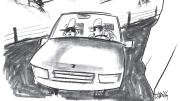Men are from Mars, and women are from Venus. Right? The subject of sex differences is a staple of popular culture, and various fields—sociology, psychology, neurobiology, and, recently, genomics—have taken on the topic. Studies have argued that women talk more than men, that men occupy both high and low extremes of intelligence, and even, recently, that there are strong differences in the very wiring of male and female brains.
In her new book Sex Itself: The Search for Male and Female in the Human Genome, Sarah S. Richardson, an assistant professor of the history of science and of studies of women, gender, and sexuality, examines science’s claims to reveal “what is really real about male and female.” Her focus is on the sex chromosomes, the stretches of DNA referred to as X and Y that together determine biological sex in most mammals: individuals with two X chromosomes are female, and those with one X and one Y are male. The sex chromosomes, says Richardson, are “objects of scientific knowledge that have circulated between popular culture and scientific research in a way that tells us a lot about how gender beliefs”—socially constructed ideas about masculinity and femininity—“enter the cognitive work of science.”
She begins her series of case studies by examining the discovery of the sex chromosomes themselves at the turn of the twentieth century. Contrary to what the Victorian period’s rigid sexual mores might suggest, sex was considered fluid and spectrum-like at the time, Richardson notes; early theories hypothesized that environmental signals like nutrition or temperature could affect sex determination. Attention shifted from such external factors to each individual’s chromosomal makeup after researchers established that sex in humans correlates exactly to the presence or absence of the tiny Y chromosome. Together with the later discovery of sex hormones, the X and Y chromosomes established a new biological framework for understanding sex.
In midcentury, Richardson writes, this framework increasingly became a vehicle for social notions of gender difference, with male and female presented as opposite and complementary. In the 1970s, scientists observed that males with an extra Y chromosome were overrepresented in prison populations and hypothesized that XYY “supermales” had received an additional dose of “male” traits like aggression and physical strength. Later studies thoroughly discredited the “supermale” theory: XYY and XXY males were found to have similarly high rates of imprisonment (now attributed to slightly lower average intelligence caused by chromosomal imbalance). Even so, the XYY “supermale” theory captured the public imagination—highlighting, Richardson argues, how the X and Y chromosomes have been persistently conflated with social notions of gender.
Examples such as the XYY “supermale” theory illustrate how social ideas of gender can shape scientific inquiry, says Richardson. She is concerned not only with “black-and-white” cases of gender bias; in fact, she introduces the term “gender valence” to illustrate the varied and sometimes productive intersection of cultural and scientific understanding. Thus she highlights scientific debate over the theory of Y-chromosome degeneration, which posits that the Y chromosome is rapidly losing genes and may eventually disappear; the discussion, Richardson argues, consciously engages with societal anxieties over the status of men in a postfeminist world. “Gender beliefs are playing a role in the science here, but it doesn’t have the pejorative connotation of bias,” she explains. “Bias, in my view, happens when we insert our assumptions into scientific research in a way that is not reflective, that’s invisible to us.”
She ends by examining modern research into sex differences. In the related area of race-based research, scientists have found that individual humans have similar amounts of genetic variation, whether they are from the same or different populations, and critical dialogue has revealed the potential pitfalls of ascribing biological significance to socially constructed racial categories. Sex-difference research, Richardson argues, requires this critical perspective as well. Per the New Yorker cartoon, she cautions that “older, once debunked, theories of sex difference [have been revived] decades later in the language of molecular genetics,” as mechanisms of gene expression or neurological wiring are used to reinforce existing ideas of gender. Building on several published statistical criticisms, Richardson finds that many sex-difference studies have fundamental logical flaws: for instance, scientists often fail to distinguish properly between biological and social influences, she observes, even though gendered norms in areas ranging from exercise to workplace interactions can complicate what appear to be essential biological differences.
The errors, Richardson writes, illustrate a broader conceptual problem. It has been too convenient to think of male and female as opposite, she says; the sexes must be seen not as “natural kinds”—distinct and separate categories—but rather as “permanently paired and dynamically interacting.”“Looking over 30 or 40 years of critical discussions of gender in science,” she says, “we can document how those conversations have begun to change and benefit the science” by pointing out gendered assumptions and suggesting alternative models. “The book makes the argument that we should continue to cultivate these discussions as we move into an age in which genomics will proliferate findings of human differences.”








